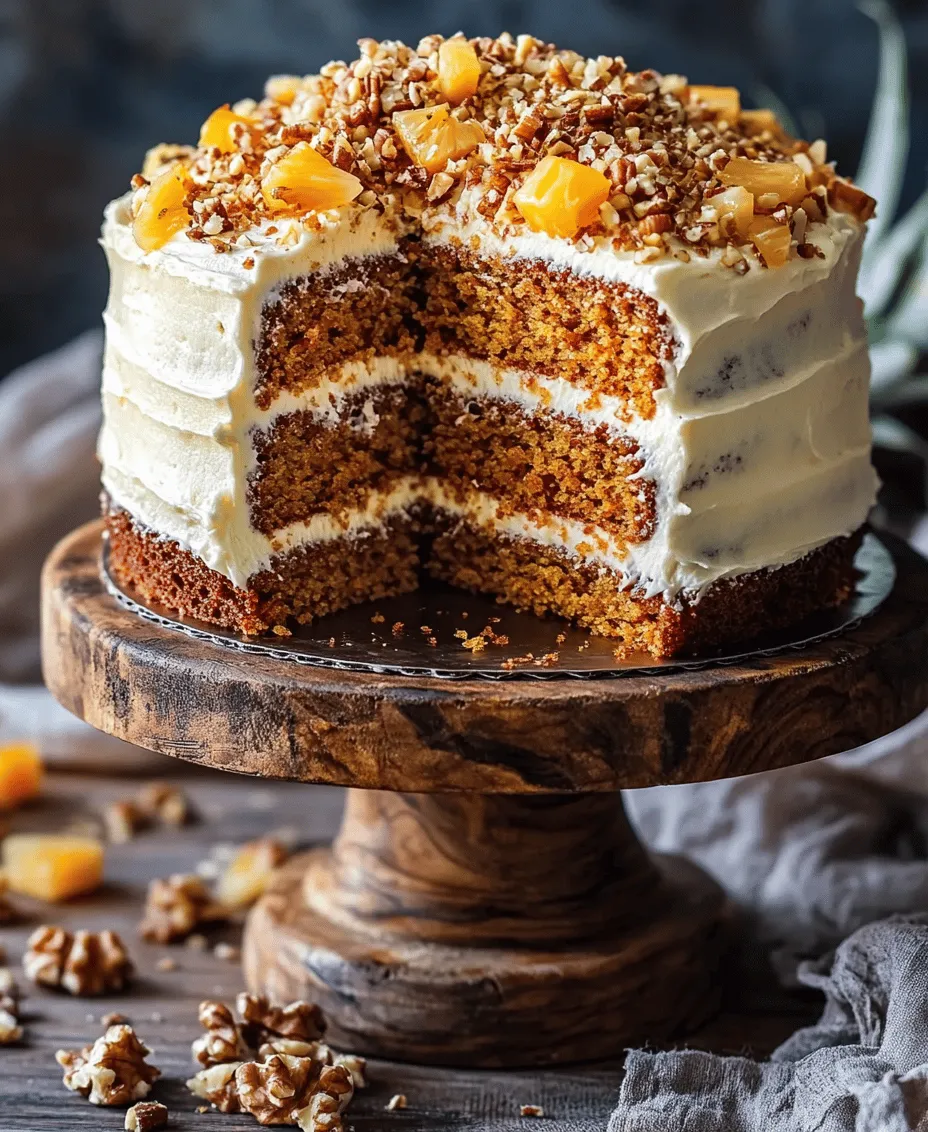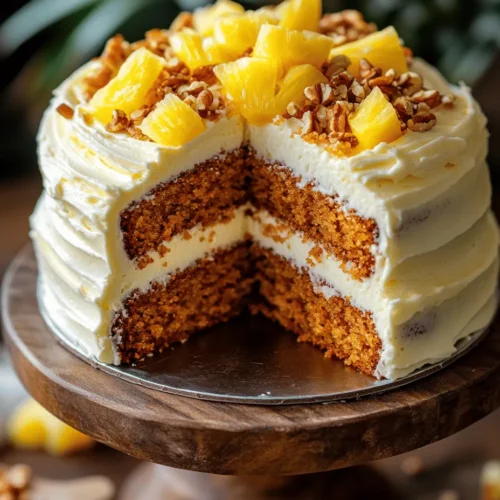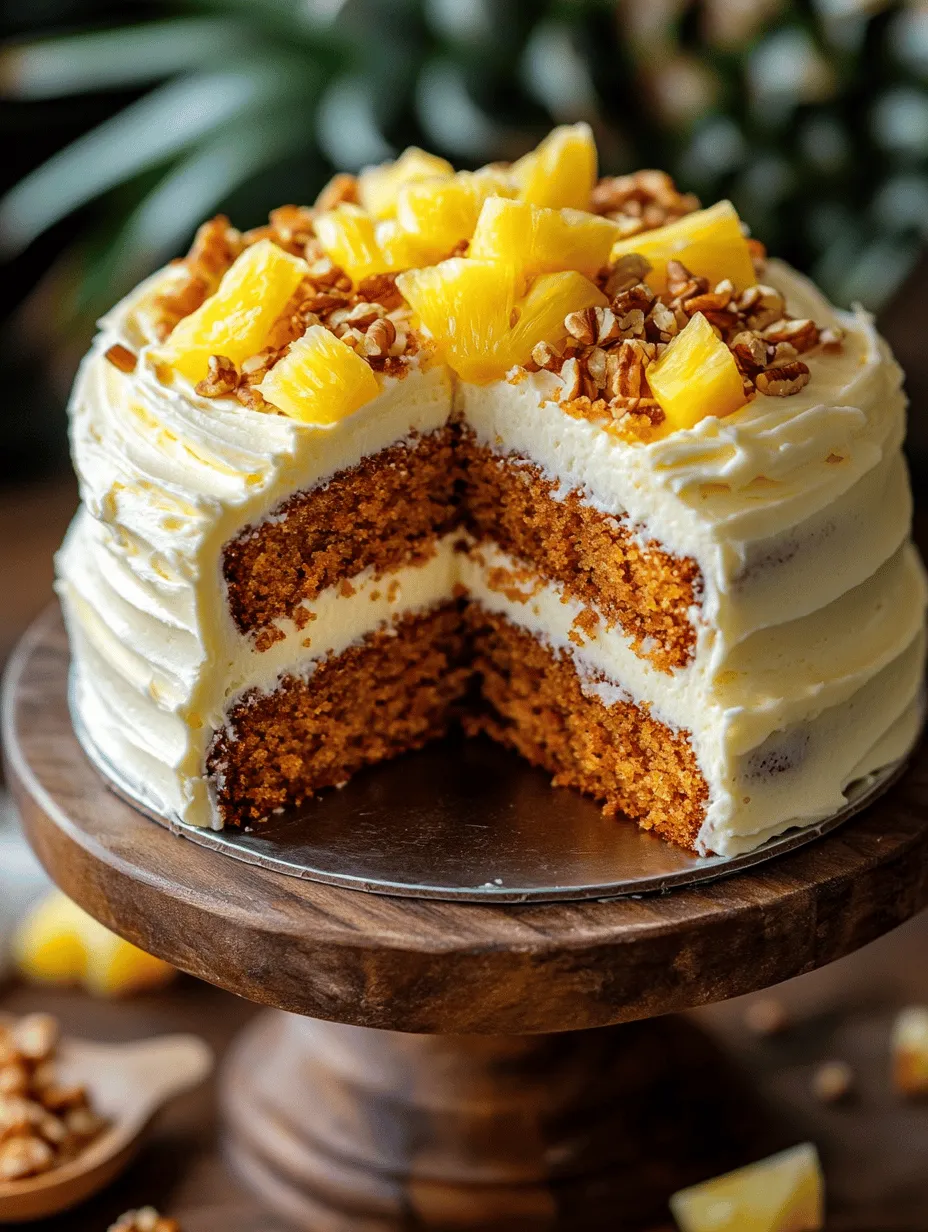Introduction
Hawaiian Carrot Pineapple Cake is a delightful dessert that perfectly marries the traditional flavors of a classic carrot cake with the sweet, tropical essence of pineapple. This cake not only captivates the palate but also transports you to sun-kissed shores with every bite. The combination of grated carrots and crushed pineapple results in a moist, flavorful cake that is as vibrant as it is delicious.
Incorporating tropical flavors into traditional desserts is an exciting culinary trend that reflects a growing appreciation for international cuisine. The addition of pineapple brings a tangy sweetness that complements the earthy flavor of carrots, creating a harmonious balance that makes this cake stand out. Whether you’re celebrating a special occasion or simply indulging in a sweet treat, Hawaiian Carrot Pineapple Cake offers a refreshing twist that’s sure to impress.
In this article, we will guide you through the process of making this mouthwatering cake. We will cover the essential ingredients, their roles in the baking process, and share valuable tips to ensure your cake turns out perfectly. From preparing your baking pans to the final touches of frosting, you’ll have everything you need to create an unforgettable dessert.
Understanding the Ingredients
To craft the perfect Hawaiian Carrot Pineapple Cake, it’s crucial to understand the role each ingredient plays in achieving the desired flavor and texture. Here’s a detailed analysis of the key components:
All-Purpose Flour
All-purpose flour serves as the foundation for the cake, providing structure and stability. The gluten in the flour helps the cake rise while maintaining a tender crumb. It’s essential to measure the flour accurately, as too little can result in a dense cake, while too much can lead to a dry texture. For best results, use the spoon-and-level method when measuring flour.
Granulated Sugar
Sugar is not just a sweetener; it plays a vital role in the cake’s overall moisture and flavor. Granulated sugar helps to retain moisture during baking, ensuring that the cake remains soft and tender. It also contributes to the caramelization process, which enhances the cake’s flavor and gives it a beautiful golden hue. The right amount of sugar is key to balancing the sweetness of the carrots and pineapple.
Baking Soda and Baking Powder
These leavening agents are crucial for creating a light and fluffy cake. Baking soda is a base that reacts with the acidity of the pineapple, helping the cake rise. On the other hand, baking powder contains both acid and base components, providing an additional lift. Using both ensures that the cake achieves the perfect rise and texture, making it airy and enjoyable.
Ground Cinnamon
Ground cinnamon adds warmth and depth to the cake. Its aromatic qualities complement the sweetness of the carrots and pineapple, enriching the overall flavor profile. Cinnamon is a common spice in many baked goods, and its inclusion in this recipe brings a familiar warmth that enhances the tropical notes without overpowering them.
Carrots
Carrots are not only the star ingredient in this cake but also bring nutritional benefits. Packed with vitamins and antioxidants, they contribute natural sweetness and moisture to the cake. Grating the carrots finely ensures they blend seamlessly into the batter, providing a subtle texture that enhances the cake without making it overly dense.
Pineapple
Crushed pineapple introduces a juicy sweetness and tropical flair to the cake. It not only adds flavor but also contributes moisture, ensuring that the cake remains moist and tender. When using crushed pineapple, it’s important to drain the juice to prevent the batter from becoming too wet, which can affect the cake’s structure.
Nuts (Optional)
Nuts, such as walnuts or pecans, can be added for extra texture and flavor contrast. They provide a delightful crunch that complements the soft cake, adding complexity to each bite. If you choose to include nuts, make sure to chop them coarsely for even distribution throughout the batter.
Eggs and Vegetable Oil
Eggs act as a binding agent, helping to hold the ingredients together while contributing to the cake’s moisture. They also add richness and a slight leavening effect. Vegetable oil, on the other hand, enhances the cake’s moisture content, making it incredibly soft. The combination of eggs and oil ensures a tender crumb that is characteristic of a well-made cake.
Preparation Steps in Detail
Before diving into mixing your ingredients, it’s essential to prepare your baking pans properly. This step is often overlooked but is crucial for ensuring that your cake releases easily after baking. Start by greasing your cake pans with vegetable oil or butter, ensuring that every corner is covered. Then, lightly dust the pans with flour, tapping out any excess. This process creates a barrier that prevents the cake from sticking and helps achieve a smooth finish.
Mixing Methods: Dry vs. Wet
Understanding the difference between dry and wet mixing methods is key to achieving the right texture in your cake. The dry ingredients, including flour, baking soda, baking powder, cinnamon, and sugar, should be combined in one bowl. This ensures even distribution of the leavening agents and spices.
In a separate bowl, combine the wet ingredients: beaten eggs, vegetable oil, crushed pineapple, and grated carrots. Mixing the wet and dry ingredients separately prevents overmixing, which can lead to a dense cake. When you combine the two mixtures, do so gently, folding the ingredients together until just combined. This technique helps retain air in the batter, resulting in a light and airy cake.
Grating Carrots and Measuring Pineapple
When it comes to preparing your carrots, it’s best to use a box grater or food processor for a fine grate. This finer texture allows the carrots to blend seamlessly into the batter, ensuring even distribution. For the crushed pineapple, make sure to drain any excess juice thoroughly. This prevents the batter from becoming too wet, which can result in a soggy cake.
Folding in Ingredients
Folding in the ingredients is a gentle mixing technique that helps maintain the lightness of the batter. Once you combine the wet and dry mixtures, use a rubber spatula to carefully fold the ingredients together. Start from the bottom of the bowl, lifting and turning the batter over itself. This method ensures that you incorporate all the flour without overworking the gluten, which can lead to a denser cake.
As you fold, be mindful of the consistency of the batter. It should be thick but pourable, with no dry pockets of flour remaining. If you’ve added nuts, gently fold them in at this stage, ensuring they are evenly distributed throughout the mixture.
Baking the Cake
Once your batter is ready, it’s time to bake the cake. Preheat your oven to the specified temperature, usually around 350°F (175°C). Pour the batter evenly into the prepared cake pans, filling them about two-thirds full to allow room for rising.
Baking times may vary depending on your oven and the size of your pans, but typically, the cakes will bake for 25 to 30 minutes. To check for doneness, insert a toothpick into the center of the cake. If it comes out clean or with a few moist crumbs, your cake is ready to be removed from the oven.
Allow the cakes to cool in the pans for about 10 minutes before transferring them to a wire rack. Cooling the cakes in the pan helps them set while also making it easier to remove them without breaking. Once completely cooled, your cake is ready for frosting and decorating, paving the way for a stunning presentation that will surely impress your family and friends.
Stay tuned as we explore the best frosting techniques and decoration ideas in the next part of this article.

Ideal Baking Conditions and Temperature Settings
To achieve the perfect Hawaiian Carrot Pineapple Cake, it’s essential to create the right baking environment. Preheat your oven to 350°F (175°C), ensuring that it reaches the right temperature before placing your cake inside. This temperature allows the cake to rise properly and develop a moist texture.
When baking, it’s crucial to use the middle rack of your oven, as this position allows for even heat distribution, preventing the top from browning too quickly. Be sure to keep an eye on your cake during the last few minutes of baking; every oven behaves differently, so slight adjustments might be necessary.
Recognizing When the Cake is Done: Toothpick Test Explained
Determining when your Hawaiian Carrot Pineapple Cake is done is simple with the toothpick test. Insert a toothpick or a cake tester into the center of the cake. If it comes out clean or with just a few moist crumbs attached, your cake is ready to be removed from the oven. If the toothpick comes out with wet batter, return the cake to the oven and check again after a few minutes. This method ensures that your cake is perfectly baked, avoiding undercooked or dry results.
Cooling Techniques to Prevent Sogginess
Once your cake is out of the oven, it’s vital to cool it properly to prevent it from becoming soggy. Start by allowing the cake to cool in the pan for about 10-15 minutes. This initial cooling period helps it settle and makes it easier to remove from the pan without breaking. After this, carefully transfer the cake to a wire rack to cool completely. Placing the cake on a wire rack allows air to circulate around it, preventing moisture buildup that can lead to sogginess. Make sure the cake is completely cool before applying frosting to ensure the frosting does not melt or slide off.
Creating the Cream Cheese Frosting
Basic Cream Cheese Frosting Recipe
To elevate your Hawaiian Carrot Pineapple Cake, a luscious cream cheese frosting is a must. Here’s a simple recipe:
– Ingredients:
– 8 oz cream cheese, softened
– 1/2 cup unsalted butter, softened
– 4 cups powdered sugar
– 1 tsp vanilla extract
– 1-2 tbsp milk or cream (as needed for consistency)
Instructions:
1. In a large mixing bowl, beat the softened cream cheese and butter together until creamy and smooth.
2. Gradually add the powdered sugar, mixing on low speed until incorporated. Increase the speed to medium and continue beating until fluffy.
3. Add in the vanilla extract, and if the frosting is too thick, add milk or cream one tablespoon at a time until you reach your desired consistency.
Importance of Room Temperature Ingredients
Using room temperature ingredients is critical in creating a smooth and fluffy frosting. When cream cheese and butter are at room temperature, they blend together more seamlessly, preventing lumps and ensuring a light texture in your frosting.
Variations on Classic Frosting
To add a unique twist to your frosting, consider incorporating different flavors. For a tropical flair, you might add coconut extract or a bit of fresh citrus juice (like lemon or orange) to echo the flavors in the cake. For an added crunch, fold in some shredded coconut or finely chopped nuts, such as pecans or walnuts, into the frosting for a delightful texture.
Techniques for Applying Frosting Smoothly
When it comes to frosting the cake, a few techniques can help you achieve a professional look. Use a spatula or an offset knife to spread the frosting evenly across the top and sides of the cake. For a smooth finish, dip your spatula in warm water and wipe it dry before smoothing over the frosting. This technique helps to prevent the frosting from pulling or tearing the cake, leading to a beautiful presentation.
Decorating the Hawaiian Carrot Pineapple Cake
Ideas for Presentation: Tropical-Themed Decorations
For a delightful presentation that captures the essence of Hawaii, consider decorating your cake with tropical-themed elements. Fresh pineapple slices, edible flowers, or even small paper umbrellas can add a festive touch. A sprinkle of toasted coconut on top can enhance the cake’s visual appeal and flavor profile.
Using Additional Crushed Pineapple or Nuts for Garnish
For added texture and flavor, consider garnishing with more crushed pineapple or a handful of chopped nuts. This not only enhances the visual appeal but also adds a lovely crunch and moisture to each slice. If you want to keep it simple, a light dusting of powdered sugar can also provide a beautiful contrast against the creamy frosting.
Suggestions for Serving Options
When it comes to serving your Hawaiian Carrot Pineapple Cake, consider slicing it into generous pieces and layering each slice with extra frosting for a decadent treat. Alternatively, you can serve it as a multi-layer cake, stacking multiple layers of cake with frosting in between for a show-stopping dessert.
Pairing Suggestions
Beverage Pairings
To complement the flavors of the Hawaiian Carrot Pineapple Cake, think about serving it with refreshing beverages. A cup of rich coffee or a light herbal tea would pair beautifully with the sweetness of the cake. For a tropical twist, offer some fresh fruit juices, such as pineapple or mango, which can enhance the cake’s tropical flavors.
Ideal Occasions for Serving This Cake
This cake shines at various gatherings. It’s perfect for birthdays, summer barbecues, or potlucks where you want to impress your friends and family with a unique dessert. Its tropical flavors make it an ideal choice for luau-themed parties or any celebration that calls for a touch of paradise.
Nutritional Information
Breakdown of Calories, Fats, Sugars Per Serving
For those mindful of nutrition, here’s a general breakdown per serving (based on a 12-serving cake):
– Calories: approximately 320
– Total Fat: 15g
– Saturated Fat: 7g
– Sugars: 25g
Keep in mind that these values can vary based on portion size and specific ingredients used.
Discussion on the Health Benefits of Ingredients
This cake boasts some health benefits due to its key ingredients. Carrots are rich in beta-carotene, fiber, and antioxidants, while pineapple provides vitamin C and manganese, boosting your immune system. The use of whole grain flour (if substituted) can also increase fiber content, making this cake a more wholesome dessert option.
Considerations for Dietary Restrictions
For those with dietary restrictions, you can easily make this cake gluten-free by using a gluten-free all-purpose flour blend. Additionally, for nut-free options, simply omit any nuts in the cake or frosting. Always ensure that other ingredients, especially baking powder and vanilla extract, are certified gluten-free if necessary.
Conclusion
The Hawaiian Carrot Pineapple Cake is a delightful combination of flavors and textures, perfectly blending the sweetness of pineapple with the warmth of spices and the richness of cream cheese frosting. This cake not only brings a taste of the tropics to your table but also offers a chance to create lasting memories with loved ones over homemade desserts.
Baking this cake at home is a rewarding experience that allows you to share joy and deliciousness at any gathering. So, gather your ingredients and let the aroma of this tropical treat fill your kitchen. You’ll be glad you did, and your friends and family will thank you for this unforgettable indulgence. Indulge in the joy of baking and savor the delightful flavors of this Hawaiian Carrot Pineapple Cake!


